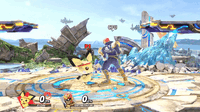| Welcome to SmashWiki! Log in or create an account and join the community, and don't forget to read this first! |
| Notices |
|---|
| The Skill parameter has been removed from Smasher infoboxes, and in its place are the new "Best historical ranking" and "Best tournament result" parameters. SmashWiki needs help adding these new parameters to Smasher infoboxes, refer to the guidelines here for what should be included in these new parameters. |
| When adding results to Smasher pages, include each tournament's entrant number in addition to the player's placement, and use the {{Trn}} template with the matching game specified. Please also fix old results on Smasher pages that do not abide to this standard. Refer to our Smasher article guidelines to see how results tables should be formatted. |
| Check out our project page for ongoing projects that SmashWiki needs help with. |
Instant double jump: Difference between revisions
mNo edit summary |
(→Videos) |
||
| (3 intermediate revisions by 2 users not shown) | |||
| Line 1: | Line 1: | ||
{{ArticleIcons| | {{ArticleIcons|allgames=y}} | ||
{{Video|All of the videos on this page are for Ultimate specifically. Would it be possible to find some for other games?}} | {{Video|All of the videos on this page are for Ultimate specifically. Would it be possible to find some for other games?}} | ||
An '''instant double jump''', or '''IDJ''' for short, is the act of inputting a [[double jump]] immediately after a [[jump]], ideally as low to the ground as possible. | An '''instant double jump''', or '''IDJ''' for short, is the act of inputting a [[double jump]] immediately after a [[jump]], ideally as low to the ground as possible. | ||
| Line 9: | Line 8: | ||
An instant double jump is a double jump performed immediately after inputting Jump. In most cases, this is done by buffering a double jump during a character's jumpsquat. If done correctly, the particles from the double jump should appear close to the ground. | An instant double jump is a double jump performed immediately after inputting Jump. In most cases, this is done by buffering a double jump during a character's jumpsquat. If done correctly, the particles from the double jump should appear close to the ground. | ||
Since | Since most characters' double jump heights are different from their jump heights, the distance covered by an instant double jump is different from a short hop or full hop. | ||
The applications of this are numerous. For example, certain windows for late [[auto-canceling]] that are between the two jump heights can be achieved with an instant double jump or IDJ [[fast fall]]. In addition, certain aerials that can only be used once during a short hop can be used twice during an IDJ or followed up with additional aerials. This also makes them useful for combos, since the altered jump height can allow you to extend your combo or hit certain follow-ups at percents or positions that would not be possible otherwise. | The applications of this are numerous. For example, certain windows for late [[auto-canceling]] that are between the two jump heights can be achieved with an instant double jump or IDJ [[fast fall]]. In addition, certain aerials that can only be used once during a short hop can be used twice during an IDJ or followed up with additional aerials. This also makes them useful for combos, since the altered jump height can allow you to extend your combo or hit certain follow-ups at percents or positions that would not be possible otherwise. | ||
| Line 16: | Line 15: | ||
==Videos== | ==Videos== | ||
{{#widget:YouTube|id=kTUC2AF01Og}} | |||
{{#widget:YouTube|id=DJfzDibpgKc}} | {{#widget:YouTube|id=DJfzDibpgKc}} | ||
{{#widget:YouTube|id=FT1FCiG2c20}} | {{#widget:YouTube|id=FT1FCiG2c20}} | ||
Latest revision as of 08:07, January 25, 2025
An instant double jump, or IDJ for short, is the act of inputting a double jump immediately after a jump, ideally as low to the ground as possible.
Details[edit]

An instant double jump is a double jump performed immediately after inputting Jump. In most cases, this is done by buffering a double jump during a character's jumpsquat. If done correctly, the particles from the double jump should appear close to the ground.
Since most characters' double jump heights are different from their jump heights, the distance covered by an instant double jump is different from a short hop or full hop.
The applications of this are numerous. For example, certain windows for late auto-canceling that are between the two jump heights can be achieved with an instant double jump or IDJ fast fall. In addition, certain aerials that can only be used once during a short hop can be used twice during an IDJ or followed up with additional aerials. This also makes them useful for combos, since the altered jump height can allow you to extend your combo or hit certain follow-ups at percents or positions that would not be possible otherwise.
An obvious drawback of instant double jumps is that they use up your double jump. This can be extremely detrimental if you end up offstage for whatever reason, since recovery becomes much more difficult for a lot of characters without it.

